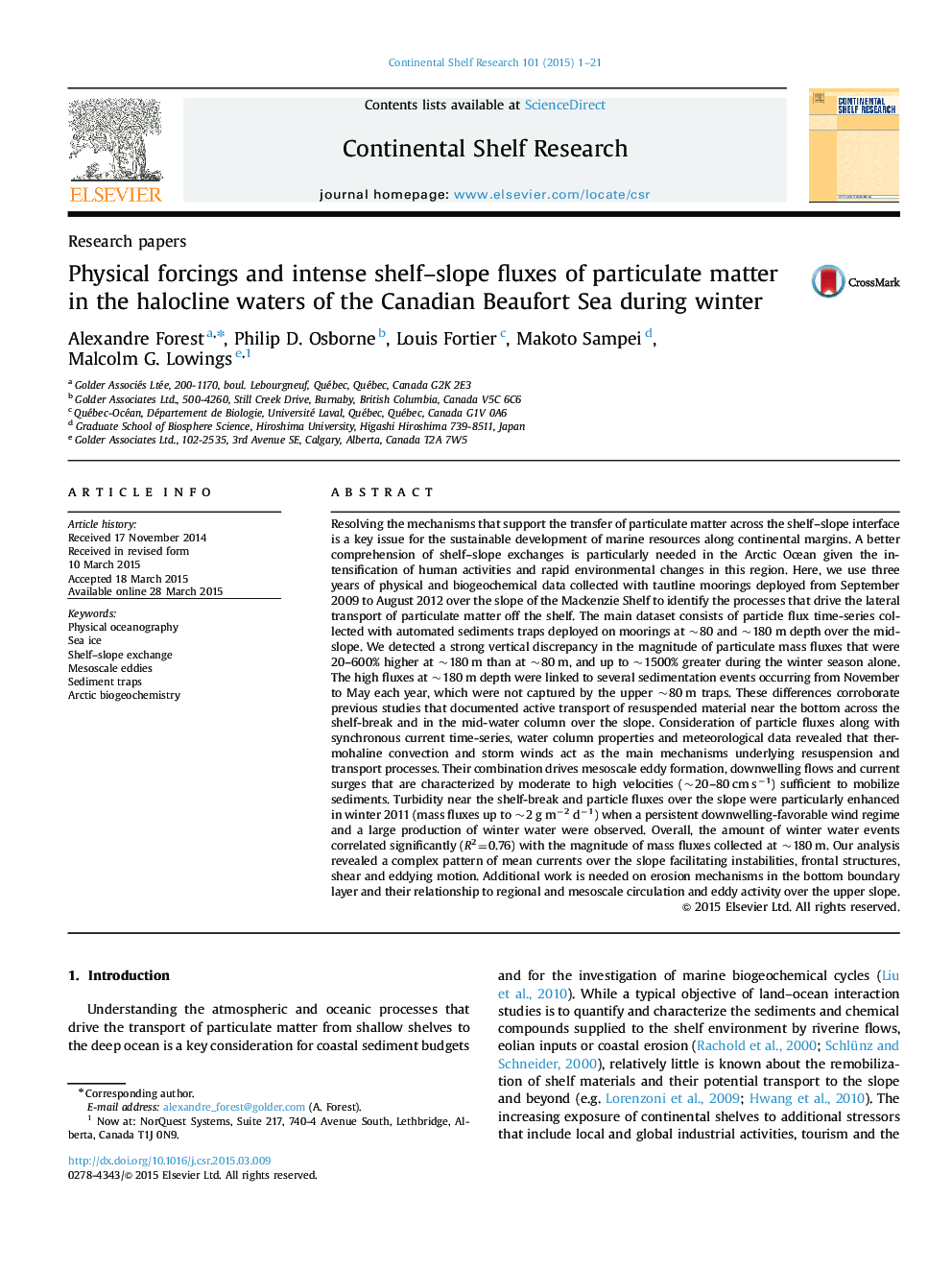| کد مقاله | کد نشریه | سال انتشار | مقاله انگلیسی | نسخه تمام متن |
|---|---|---|---|---|
| 6383124 | 1626111 | 2015 | 21 صفحه PDF | دانلود رایگان |
عنوان انگلیسی مقاله ISI
Physical forcings and intense shelf-slope fluxes of particulate matter in the halocline waters of the Canadian Beaufort Sea during winter
ترجمه فارسی عنوان
قوای فیزیکی و شیب های شدید شیب انبوه ذرات در آبهای هاللکلین دریای کانادا بوفورت در طول زمستان
دانلود مقاله + سفارش ترجمه
دانلود مقاله ISI انگلیسی
رایگان برای ایرانیان
کلمات کلیدی
اقیانوس شناسی فیزیکی، یخ دریایی، شفاف شیب مبادله، صدای مادون قرمز، تله رسوب، زیست زیستی قطب شمال،
موضوعات مرتبط
مهندسی و علوم پایه
علوم زمین و سیارات
زمین شناسی
چکیده انگلیسی
Resolving the mechanisms that support the transfer of particulate matter across the shelf-slope interface is a key issue for the sustainable development of marine resources along continental margins. A better comprehension of shelf-slope exchanges is particularly needed in the Arctic Ocean given the intensification of human activities and rapid environmental changes in this region. Here, we use three years of physical and biogeochemical data collected with tautline moorings deployed from September 2009 to August 2012 over the slope of the Mackenzie Shelf to identify the processes that drive the lateral transport of particulate matter off the shelf. The main dataset consists of particle flux time-series collected with automated sediments traps deployed on moorings at ~80 and ~180 m depth over the mid-slope. We detected a strong vertical discrepancy in the magnitude of particulate mass fluxes that were 20-600% higher at ~180 m than at ~80 m, and up to ~1500% greater during the winter season alone. The high fluxes at ~180 m depth were linked to several sedimentation events occurring from November to May each year, which were not captured by the upper ~80 m traps. These differences corroborate previous studies that documented active transport of resuspended material near the bottom across the shelf-break and in the mid-water column over the slope. Consideration of particle fluxes along with synchronous current time-series, water column properties and meteorological data revealed that thermohaline convection and storm winds act as the main mechanisms underlying resuspension and transport processes. Their combination drives mesoscale eddy formation, downwelling flows and current surges that are characterized by moderate to high velocities (~20-80 cm sâ1) sufficient to mobilize sediments. Turbidity near the shelf-break and particle fluxes over the slope were particularly enhanced in winter 2011 (mass fluxes up to ~2 g mâ2 dâ1) when a persistent downwelling-favorable wind regime and a large production of winter water were observed. Overall, the amount of winter water events correlated significantly (R2=0.76) with the magnitude of mass fluxes collected at ~180 m. Our analysis revealed a complex pattern of mean currents over the slope facilitating instabilities, frontal structures, shear and eddying motion. Additional work is needed on erosion mechanisms in the bottom boundary layer and their relationship to regional and mesoscale circulation and eddy activity over the upper slope.
ناشر
Database: Elsevier - ScienceDirect (ساینس دایرکت)
Journal: Continental Shelf Research - Volume 101, 15 June 2015, Pages 1-21
Journal: Continental Shelf Research - Volume 101, 15 June 2015, Pages 1-21
نویسندگان
Alexandre Forest, Philip D. Osborne, Louis Fortier, Makoto Sampei, Malcolm G. Lowings,
